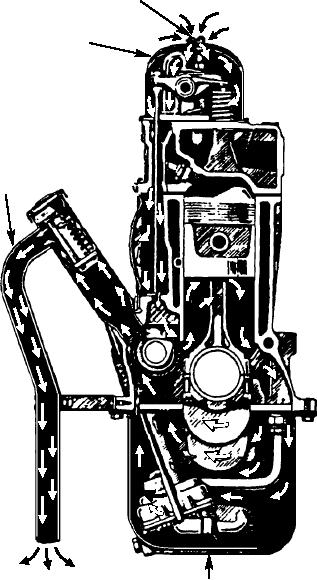
OPENING
AIR
troughs underneath the connecting rod bearing caps.
VA LV E
These troughs are kept filled by the oil pump, which
COVER
delivers the oil through nozzles.
CRANKCASE VENTILATION
There are two reasons for crankcase ventilation
during normal operation. It removes gasoline and
B R E AT H E R
water that trickle into the crankcase during the normal
TUBE
process of combustion; such gas and water mixes with
the oil and forms a pasty sludge if allowed to remain in
the crankcase. Ventilation also allows the crankcase to
breathe in order to eliminate excessive pressure in the
crankcase.
There are two methods of eliminating gasoline and
water from the crankcase--the non-positive method
and the positive method. The non-positive method
depends on a breather tube. Air flows past the open end
of the tube, evaporating the water and the gasoline and
removing the vapors from the crankcase. One end of
the breather tube opens into the crankcase above the oil
level. The other end extends down under the vehicle,
where there is sufficient airflow to create a low
pressure at the open end of the tube (fig. 5-21). The
pressure differential between the crankcase and the
open end of the tube is sufficient to force any vapors out
of the crankcase. Some breather tubes are placed so
ASf05021
VA P O R
that the cooling fan will increase the flow of air passing
CRANKCASE
over them, increasing their ventilating abilities.
Figure 5-21.--Crankshaft breather tube.
In the positive method, air is drawn through the
engine by an intake manifold vacuum; or, in other
Oil and Filter Change
words, the intake manifold vacuum draws air through
Whenever the engine oil feels gritty when
the crankcase to sweep vapors out of it (fig. 5-22).
rubbed between your fingers or has no body, it has
After picking up these vapors as it circulates through
lost its lubricating qualities and should be changed.
the crankcase, the air is forced upward and out of the
In any case, oil and filter changes are made in
engine through an opening in the valve cover, and it is
accordance with periodic maintenance (PM)
then drawn through a tube connected to the intake
schedules. On most of your equipment, the grade
manifold.
and quantity of the oil to be used can be found on the
To promote vaporization of volatile impurities and
MRC or in the technical manual. The oil should be
their removal from the crankcase, the operating
changed more frequently in cold weather and in
temperature of the engine should be at least 140F.
vehicles operated under dusty or other very
unfavorable conditions. Your chief or leading petty
LUBRICATION SYSTEM MAINTENANCE
officer will give you specific directions about oil
changes on such vehicles.
Lubrication s y s t e m m a i n t e n a n c e n o r m a l l y
consists of changing the oil and filters. Occasionally
Drain the oil only after the engine has been run
you might be required to perform such maintenance
and is warmed up. This warm-up period will thin the
tasks as replacing lines and fittings, servicing the oil
oil and stir up the sludge and foreign matter in the oil
pump and relief valve, and flushing the system.
pan. Cold oil is thick and will not drain readily, and
5-21

